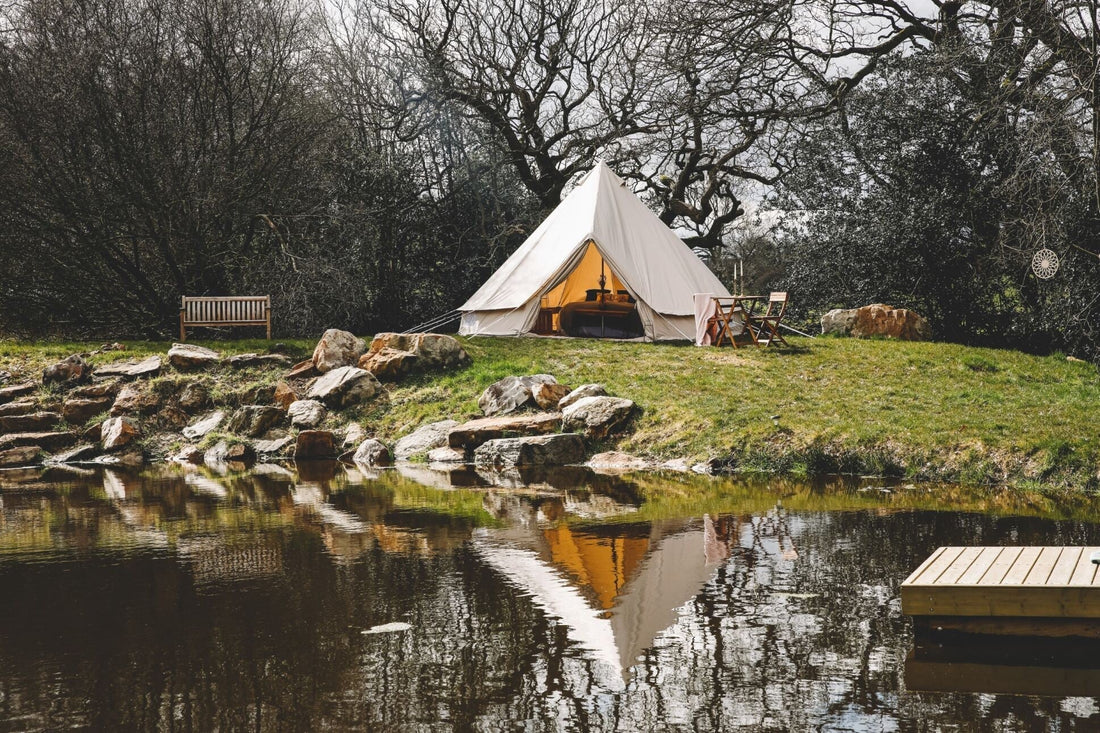
How to Pitch a Bell Tent: A Step-by-Step Guide for Stress-Free Setup
Share
Bell tents are a timeless choice for camping enthusiasts, offering a blend of style, space, and comfort. But if you’re new to bell tents, pitching one might seem a bit daunting. Don’t worry—setting up a bell tent is easier than you think! With this guide, you’ll master the art of pitching your bell tent in no time, turning your camping trips into hassle-free adventures.
Why Bell Tents Are Worth the Effort
Bell tents aren’t just about aesthetics. Their simple, central-pole design makes them incredibly sturdy and easy to pitch compared to more complex tent structures. Plus, their spacious interiors make them a favourite for families, glampers and festival-goers alike.
Let’s dive into the step-by-step process of pitching a bell tent, so you can enjoy all the benefits of this camping classic.

What You’ll Need to Pitch a Bell Tent
Before you start, make sure you have all the components:
The tent canvas
Central pole
A-frame door pole
Pegs and guy ropes
Mallet (for driving pegs into the ground)
Optional but helpful:
A tarp or footprint to protect the groundsheet
Step 1: Choose the Perfect Spot
Picking the right location is key to a successful pitch. Look for:
Flat, level ground: Avoid slopes or uneven terrain if you can.
Grass or soft ground: This makes pegging easier and prevents damage to the groundsheet.
Shade: If possible, pitch in a spot that gets some shade during the day to protect the canvas from UV damage.
Good drainage: Stay clear of low-lying areas that might collect water in case of rain.
Avoid trees: Debris from trees including sap and bird poo can cause damage to the canvas when pitching underneath trees.
Once you’ve found the spot, clear away any sharp objects like rocks or sticks that could damage the groundsheet.
Step 2: Lay Out the Tent
Unpack your bell tent and spread it out on the ground. All our tents have zipped in groundsheets so you don’t need to worry about having to use a separate groundsheet. Ensure the door is aligned with the direction you want it to face.
Step 3: Peg the Groundsheet
Start pegging the groundsheet into the ground. Use the loops around the edge to secure it, ensuring the canvas is stretched taut but not overly tight.
Pro tip: Peg opposite sides in pairs to maintain an even shape as you go.
Step 4: Insert the Central Pole
Once the base is pegged, locate the central pole. Insert it through the door and into the peak of the canvas. Push it upright in the centre of the groundsheet. The pole should stand vertical and hold the tent up like a teepee.
Step 5: Assemble the A-Frame Door Pole
The A-frame pole creates the bell tent’s door structure. Slot the pieces together and insert the top through the hole above the door and put the rain cap on top to secure it. Secure the base of the A-frame in the groundsheet’s reinforced pockets.
Step 6: Peg Out the Guy Ropes
The guy ropes are essential for stabilizing your bell tent and ensuring it stays up in windy conditions. Here’s how to get it right:
Pull each guy rope out at a 45-degree angle from the tent.
Peg the ropes into the ground using the mallet, keeping them taut but not overly tight.
Adjust the tensioners on the ropes to ensure an even shape all around.
Pro tip: Start with the guy ropes on opposite sides of the tent and work your way around to maintain balance.
Step 7: Adjust and Fine-Tune
Walk around the tent to check for any slack areas or uneven tension. Adjust the guy ropes and re-peg as needed to create a smooth, symmetrical appearance.
Step 8: Add the Finishing Touches
Once your tent is securely pitched, you can add your personal touches:
Lay down rugs, mats or carpets for a cosy interior.
Set up your beds, furniture or other camping gear.
Attach bunting or fairy lights to the guy ropes for a glamping vibe.

Common Mistakes to Avoid
Not pegging securely: Loose pegs can cause the tent to collapse in windy conditions. Always double-check your pegs.
Not checking the guy ropes: Even if the tent looks stable, guy ropes are crucial for stability, especially in bad weather.
Pitching on a slope: This can lead to an uncomfortable sleeping surface and water pooling in the tent during rain.
Pitching your bell tent correctly ensures:
Longevity: A well-pitched tent experiences less strain on the canvas and poles.
Comfort: Proper tensioning keeps the interior spacious and free of sagging walls.
Safety: A stable tent reduces the risk of collapsing during windy conditions.
Learning how to pitch a bell tent is an essential skill for any camper or glamper. With practice, you’ll be able to set it up quickly and confidently, leaving more time to relax and enjoy the great outdoors.
Ready to pitch your first bell tent? Explore our collection of Ultimate Bell Tents and Accessories to start your next adventure in style!
